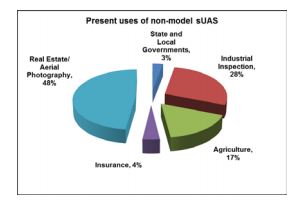The US Federal Aviation Administration (https://www.faa.gov/data_research/aviation/aerospace_forecasts/media/Unmanned_Aircraft_Systems.pdf) is predicting drone numbers to increase by 400% to 2022 – but slowing down beyond then. Professional drone numbers however “will likely be phenomenal,” according to the agency.
“By the end of May 2017, more than 772,000 owners had already registered with the FAA. While mandatory registration was in effect until the last week of May 2017, the trend was one of slowing growth over time,” said the FAA.
“Since the launch of on-line registration, more than 110,000 commercial operators had registered their equipment by the end of 2017.”
“Last year, we forecasted that the non-model sector would comprise approximately 108,000 aircraft in 2017, a growth rate exceeding 150% from the base of 42,000 in 2016. Actual data indicate there were 110,604 UAS registered at the end of 2017. Considering the trend observed in the registrations, expert opinions provided during the TRB workshops, review of available industry forecasts, internal research, and market/industry research, we project that the non-model fleet by 2022 will likely (i.e. base scenario) be four times larger than the current number of non-model aircraft. As the present base (i.e. cumulative total) gets larger, we anticipate the growth rate of the sector will slow down over time as well.”
Total non-model UAS fleet (number of units)
| Year | Base | High |
| 2017 | 110,604 | 110,604 |
| 2018 | 158,900 | 168,339 |
| 2019 | 229,400 | 268,937 |
| 2020 | 312,100 | 410,862 |
| 2021 | 407,400 | 604,550 |
| 2022 | 451,800 | 717,895 |
Other key FAA predictions:
- “We project the non-model sUAS sector will be over 450,000 in 2022. We divide the non-model sector into two types of UAS aircraft: consumer grade and professional grade…Starting from a low base of around 3,000 aircraft in 2017, professional grade non-model UAS stand to expand rapidly over time, especially as newer and more sophisticated uses are identified, designed, and planned. If, for example, professional grade UAS meet feasibility criteria of operations, safety, regulations, and economics/business, and they enter into the logistics chain via delivery of small packages, the growth in this sector will likely be phenomenal.
- Non-model UAS are primarily used for aerial imaging and data collection, including real estate photography (48%), industrial and utility inspection (28%), and agricultural applications (17%), including crop inspection. Increasingly, state and local governments are using UAS for emergency services, including search and rescue operations, and presently employ around 3% of all non-model UAS. As the sector grows, there will be many more non-model UAS in use.
- Beyond what is presently allowed under Part 107, expanding non-model applications requires waivers for night operations (86% of all waivers granted), operation of multiple unmanned aircraft by one pilot (1.5%), and operations above current altitude limits (1.3%). Many of these waivers include combinations of multiple waived provisions, and hence, totalling waivers granted by provision (more than 1,600 in December 2017) exceeds 100%.
- Almost 13,000 airspace authorizations and waivers were approved for UAS operations in controlled airspaces by the end of December 2017. While over half of them were for operation in class D airspace (i.e., smaller airports with control towers), waivers for operation in other classes were also requested and approved.
- An important final metric in non-model sUAS is the trend in remote pilot certifications (RPCs). RPCs are issued in accordance with part 107 and are used primarily to facilitate non-model sUAS flights for commercial activities. As of December 2017, more than 45 73,000 RPCs were issued. Over 90% of individuals who took the required aeronautical knowledge exam passed and obtained an RPC….Starting from the base of 73,673 RPCs in 2017, non-model activities may require over 300,000 new remote pilots in 5 years.




